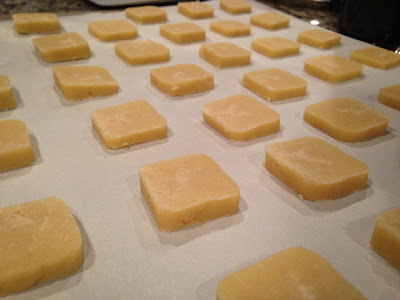 |
| Pretty classy, eh? |
A friend visiting from Italy requested that I remake a gingerbread man I had made last Christmas. I got to decorate it with her awesome son, which resulted in a ton of fond memories and food comas.
 |
| He may look healthy, but he quickly became paraplegic after this photo. |
But instead, I decided to go with the fleur de lis pattern above to make my life simpler and try something new! I couldn't find the recipe I originally used for the gingerbread man, so I settled on one that sounded reasonable online. One key difference was that it asked me to let the dough sit for 2 hours. Why?! I have things to do! I can't be all waiting and stuff! So I decided to investigate to see if it was a truly necessary step or could be creatively skipped...
The idea behind resting the dough is so that it is easier to roll out later. This is something I didn't have to do with the gingerbread man, since I just packed him into the mold. Gluten strands form when you work dough, so letting it rest will make the dough a bit softer for the rolling pin. It will also make your cookies less tough too. Additionally, I saw many suggestions to refrigerate the dough for about 30 minutes before rolling and cutting. The idea here is to firm up the butter to make the dough less mushy. It will also reduce how much the cookies will expand in the oven, giving you cleaner, prettier shapes! Fascinating!
The cookies turned out very soft and almost like a dense cake. They were packed with ginger spicey goodness and went wonderfully with some hot tea or cold milk. I would almost prefer more of a snap, but I think that means I have a preference for ginger snaps over gingerbread cookies, and the two are quite different in texture.
Adjustments
Nothing this time around. I was a good girl and did as I was told!Next Time
I would definitely decorate them with a bit of frosting next time. Without tea, they can be a bit plain, and I am a wimp when it comes to spicy things. A little sugar would go a long way for me. (Yes, I did just complain that gingerbread cookies are too spicy. ...I'm not pathetic, I'm just a super taster!)
I would also be interested to try the big gingerbread man again. That dough was warm and mushy when I packed it into the pan, and the flavor was very different. I've got to find that recipe! It's also just really fun to dismember something as you eat it.
Source: http://www.food.com/recipe/the-most-wonderful-gingerbread-cookies-80156
Source: http://www.food.com/recipe/the-most-wonderful-gingerbread-cookies-80156






































